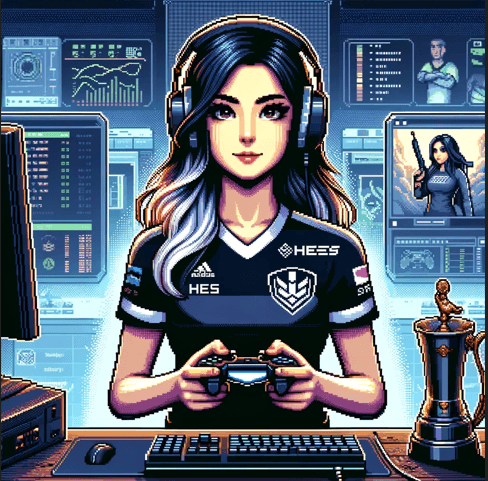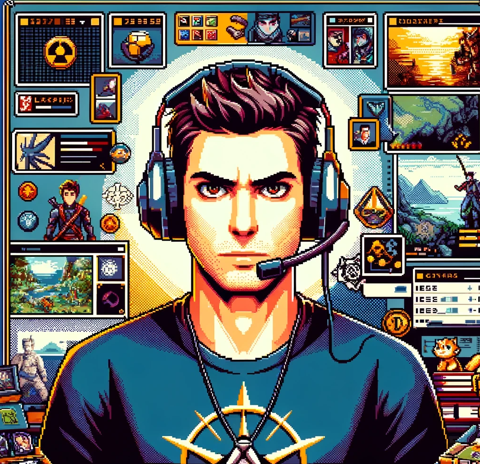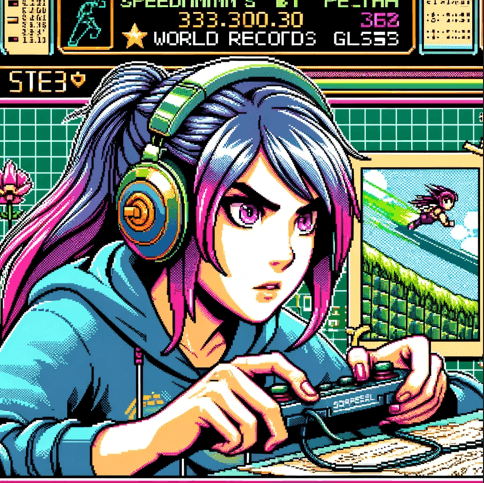 Let’s start with Undertale by Toby Fox, published independently by Toby Fox. To begin with, users consistently praise its moral choice system, which allows players to complete the game through kindness or violence. One review cleverly noted, “Time is fake. Morality is optional.” In particular, fans love the game’s innovative combat and deep emotional storytelling, which subvert traditional RPG expectations. However, some players point out difficulty spikes—especially during Genocide runs—as a disruption to the narrative flow. That said, these spikes also create high-stakes tension that amplifies the experience. From a competitive gamer’s perspective, I especially appreciate the tight mechanics and consequential choices, which elevate its replayability and skill ceiling.
Let’s start with Undertale by Toby Fox, published independently by Toby Fox. To begin with, users consistently praise its moral choice system, which allows players to complete the game through kindness or violence. One review cleverly noted, “Time is fake. Morality is optional.” In particular, fans love the game’s innovative combat and deep emotional storytelling, which subvert traditional RPG expectations. However, some players point out difficulty spikes—especially during Genocide runs—as a disruption to the narrative flow. That said, these spikes also create high-stakes tension that amplifies the experience. From a competitive gamer’s perspective, I especially appreciate the tight mechanics and consequential choices, which elevate its replayability and skill ceiling.
 Transitioning to mechanics, Undertale features a unique battle system that merges turn-based RPG elements with top-down bullet-dodging mechanics. Players must time attacks and actively dodge enemy projectiles while in the “soul” mode—orange hearts dodge bullets, blue hearts stay still. In many ways, this fusion reminds me of EarthBound’s quirky charm, yet Undertale pushes boundaries by encouraging non-lethal options. Throughout battles, players can negotiate, spare, or use healing items like Butterscotch Pie to recover health and influence outcomes. Notably, Toby Fox developed this ambitious game solo using GameMaker Studio, proving how powerful and personal an indie game can be when a clear creative vision leads development.
Transitioning to mechanics, Undertale features a unique battle system that merges turn-based RPG elements with top-down bullet-dodging mechanics. Players must time attacks and actively dodge enemy projectiles while in the “soul” mode—orange hearts dodge bullets, blue hearts stay still. In many ways, this fusion reminds me of EarthBound’s quirky charm, yet Undertale pushes boundaries by encouraging non-lethal options. Throughout battles, players can negotiate, spare, or use healing items like Butterscotch Pie to recover health and influence outcomes. Notably, Toby Fox developed this ambitious game solo using GameMaker Studio, proving how powerful and personal an indie game can be when a clear creative vision leads development.
 Regarding the narrative, Undertale hooks players from the start with Toriel’s maternal warmth, Flowey’s sinister twists, and Sans’s clever humor. The story’s pacing feels intuitive, with moments of levity, sorrow, and suspense spaced naturally throughout. Notably, interactive dialogue pop-ups often reveal crucial lore and subtle emotional beats. One scene that players frequently recall is Toriel’s pie-baking moment, which captures the tone of tender nostalgia. On my end, I tracked every hidden encounter, including the six roaming dogs—fans still speculate about a potential seventh dog. That mystery contributes to the game’s collectible sublayer, adding an engaging layer of replay value. Furthermore, interviews reveal that Toby Fox wrote the script, composed the soundtrack, and created the art himself—a rare and admirable solo feat in modern game development.
Regarding the narrative, Undertale hooks players from the start with Toriel’s maternal warmth, Flowey’s sinister twists, and Sans’s clever humor. The story’s pacing feels intuitive, with moments of levity, sorrow, and suspense spaced naturally throughout. Notably, interactive dialogue pop-ups often reveal crucial lore and subtle emotional beats. One scene that players frequently recall is Toriel’s pie-baking moment, which captures the tone of tender nostalgia. On my end, I tracked every hidden encounter, including the six roaming dogs—fans still speculate about a potential seventh dog. That mystery contributes to the game’s collectible sublayer, adding an engaging layer of replay value. Furthermore, interviews reveal that Toby Fox wrote the script, composed the soundtrack, and created the art himself—a rare and admirable solo feat in modern game development.
 As for the visuals, Undertale proudly uses retro pixel art, evoking 8-bit and 16-bit aesthetics while maintaining clarity and character. The color palette shifts fluidly with emotional tone—Snowdin’s wintry brightness contrasts starkly with the haunting darkness of The Core. Visually, it runs smoothly across platforms like PC, Nintendo Switch, and PlayStation, with stable frame rates even during intense bullet-hell sequences. For performance-focused players, that stability is critical. I’ve shaved seconds off boss encounters by mastering animation frame windows. A fun fact: Undertale surpassed one million copies sold within its first year, making it one of the most commercially successful indie games ever released.
As for the visuals, Undertale proudly uses retro pixel art, evoking 8-bit and 16-bit aesthetics while maintaining clarity and character. The color palette shifts fluidly with emotional tone—Snowdin’s wintry brightness contrasts starkly with the haunting darkness of The Core. Visually, it runs smoothly across platforms like PC, Nintendo Switch, and PlayStation, with stable frame rates even during intense bullet-hell sequences. For performance-focused players, that stability is critical. I’ve shaved seconds off boss encounters by mastering animation frame windows. A fun fact: Undertale surpassed one million copies sold within its first year, making it one of the most commercially successful indie games ever released.
 When it comes to music, Undertale’s soundtrack stands out as a core part of its identity. Tracks like “MEGALOVANIA,” “Hopes and Dreams,” and “Bonetrousle” seamlessly blend chiptune energy with orchestral emotion, amplifying the drama of key battles. Consequently, these compositions contribute significantly to the game’s emotional highs. Sound effects—such as bone-rattling impacts in Papyrus’s battle—subtly enhance atmosphere and tension. While there’s no voice acting, the expressive audio design carries emotional weight on its own, further immersing players in the world.
When it comes to music, Undertale’s soundtrack stands out as a core part of its identity. Tracks like “MEGALOVANIA,” “Hopes and Dreams,” and “Bonetrousle” seamlessly blend chiptune energy with orchestral emotion, amplifying the drama of key battles. Consequently, these compositions contribute significantly to the game’s emotional highs. Sound effects—such as bone-rattling impacts in Papyrus’s battle—subtly enhance atmosphere and tension. While there’s no voice acting, the expressive audio design carries emotional weight on its own, further immersing players in the world.
 Shifting to characters, Undertale offers a standout cast that defies stereotypes and leaves lasting impressions. Toriel exudes caring warmth, Undyne embodies heroic justice, and Alphys represents awkward genius. Importantly, character identities often defy traditional gender norms, adding meaningful representation. Asgore’s arc, for instance, is both heartbreaking and complex, illustrating the consequences of leadership and loss. Your choices shape their outcomes, making each interaction feel personal. Ultimately, this dynamic world-building fosters genuine emotional investment and enhances the overall narrative depth.
Shifting to characters, Undertale offers a standout cast that defies stereotypes and leaves lasting impressions. Toriel exudes caring warmth, Undyne embodies heroic justice, and Alphys represents awkward genius. Importantly, character identities often defy traditional gender norms, adding meaningful representation. Asgore’s arc, for instance, is both heartbreaking and complex, illustrating the consequences of leadership and loss. Your choices shape their outcomes, making each interaction feel personal. Ultimately, this dynamic world-building fosters genuine emotional investment and enhances the overall narrative depth.
 Looking at difficulty, the experience varies widely depending on your path. Pacifist runs are generally gentle, emphasizing puzzle-solving and conversation, while Genocide routes ramp up intensity with punishing boss fights. Some puzzles require precise timing or sharp memory, particularly during later stages. User feedback often mentions the Sans boss fight as a major spike in difficulty due to its unpredictable patterns and relentless pace. Thankfully, Undertale includes accessibility options—whether you spare or fight, the game adapts to your style. Achievement systems track every route, so you can aim for 100% completion by saving strategically and reloading to unlock branching outcomes.
Looking at difficulty, the experience varies widely depending on your path. Pacifist runs are generally gentle, emphasizing puzzle-solving and conversation, while Genocide routes ramp up intensity with punishing boss fights. Some puzzles require precise timing or sharp memory, particularly during later stages. User feedback often mentions the Sans boss fight as a major spike in difficulty due to its unpredictable patterns and relentless pace. Thankfully, Undertale includes accessibility options—whether you spare or fight, the game adapts to your style. Achievement systems track every route, so you can aim for 100% completion by saving strategically and reloading to unlock branching outcomes.
 In terms of replay value, Undertale shines. The game strongly encourages three full runs—Neutral, True Pacifist, and Genocide—to uncover all narrative layers. Each path unveils unique endings, alternate scenes, and secret dialogues that enrich the overarching story. Hidden achievements like “No Mercy” or “Tune Tapping” appeal directly to speedrunners and completionists. By comparison, few titles in the RPG genre offer such meaningful replay incentives, making Undertale a long-term favorite among both casual fans and competitive players.
In terms of replay value, Undertale shines. The game strongly encourages three full runs—Neutral, True Pacifist, and Genocide—to uncover all narrative layers. Each path unveils unique endings, alternate scenes, and secret dialogues that enrich the overarching story. Hidden achievements like “No Mercy” or “Tune Tapping” appeal directly to speedrunners and completionists. By comparison, few titles in the RPG genre offer such meaningful replay incentives, making Undertale a long-term favorite among both casual fans and competitive players.
 Final thoughts: Undertale breaks genre molds with its mercy system. It combines tight mechanics, emotional narrative, and killer music. In essence, its indie success shows passion trumps budget. I recommend EarthBound for its spirit, Deltarune Chapter One for its shared universe. Lisa: The Painful for dark humor. OneShot for meta storytelling, and To The Moon for emotional depth. Together, they share strong story, unique mechanics, and memorable characters.
Final thoughts: Undertale breaks genre molds with its mercy system. It combines tight mechanics, emotional narrative, and killer music. In essence, its indie success shows passion trumps budget. I recommend EarthBound for its spirit, Deltarune Chapter One for its shared universe. Lisa: The Painful for dark humor. OneShot for meta storytelling, and To The Moon for emotional depth. Together, they share strong story, unique mechanics, and memorable characters.
